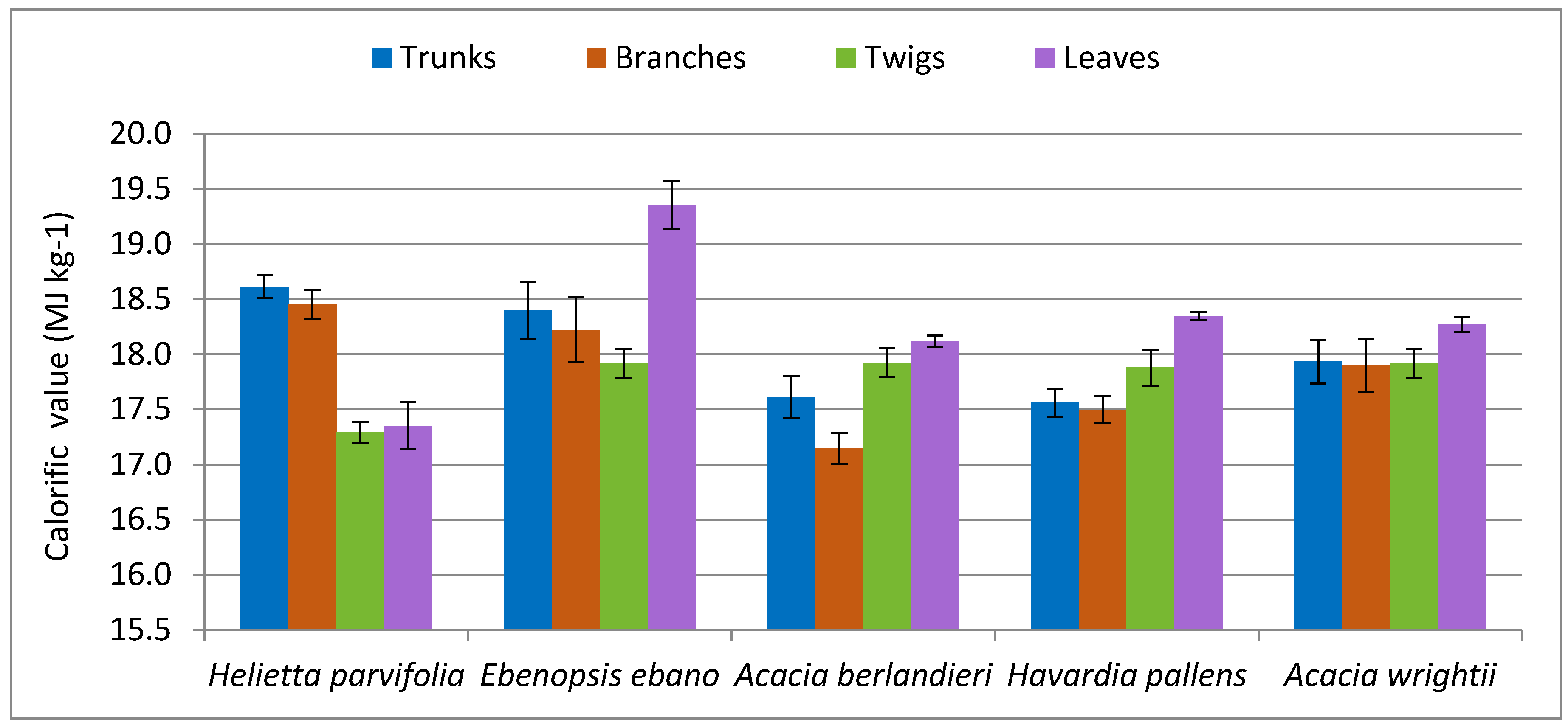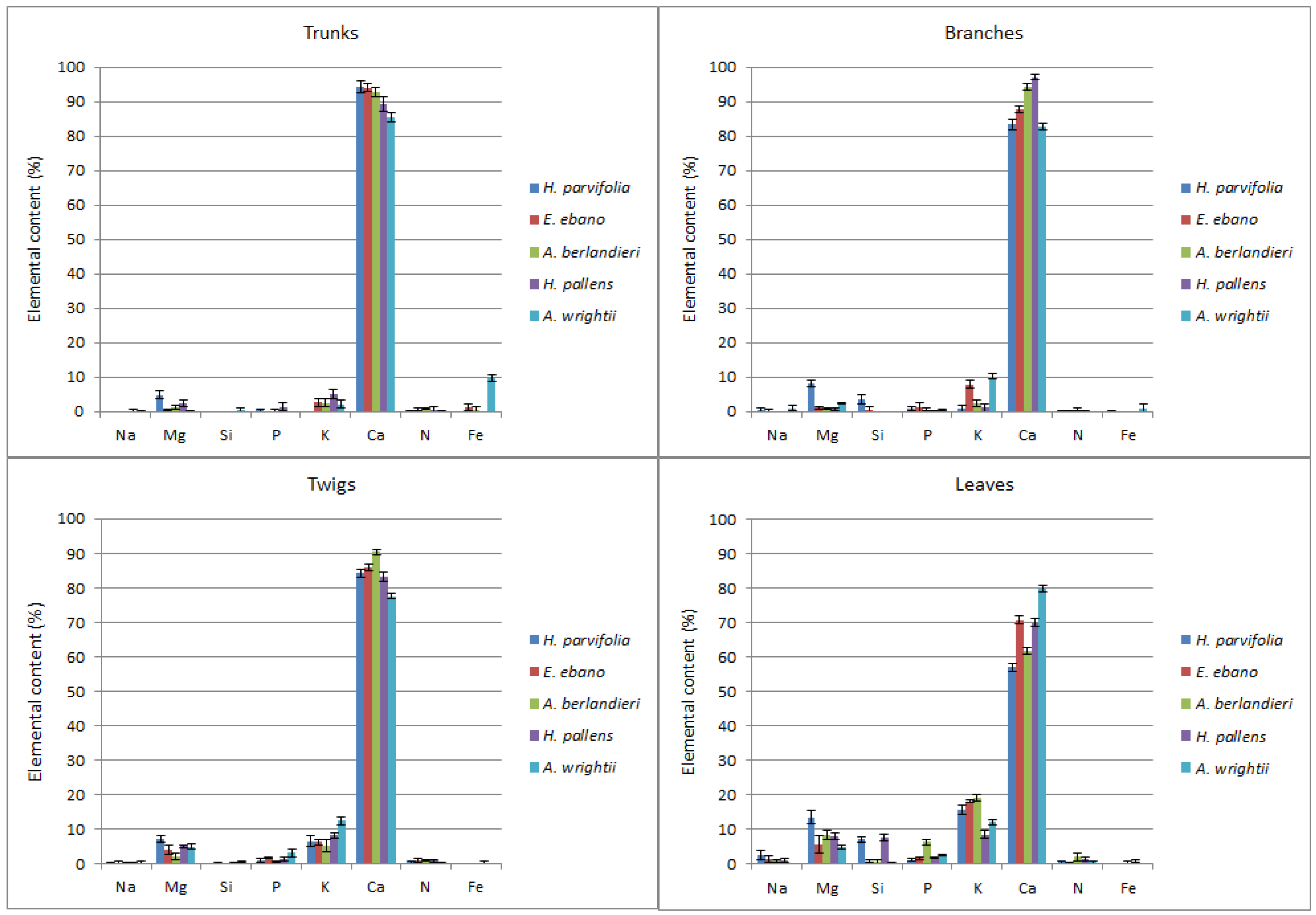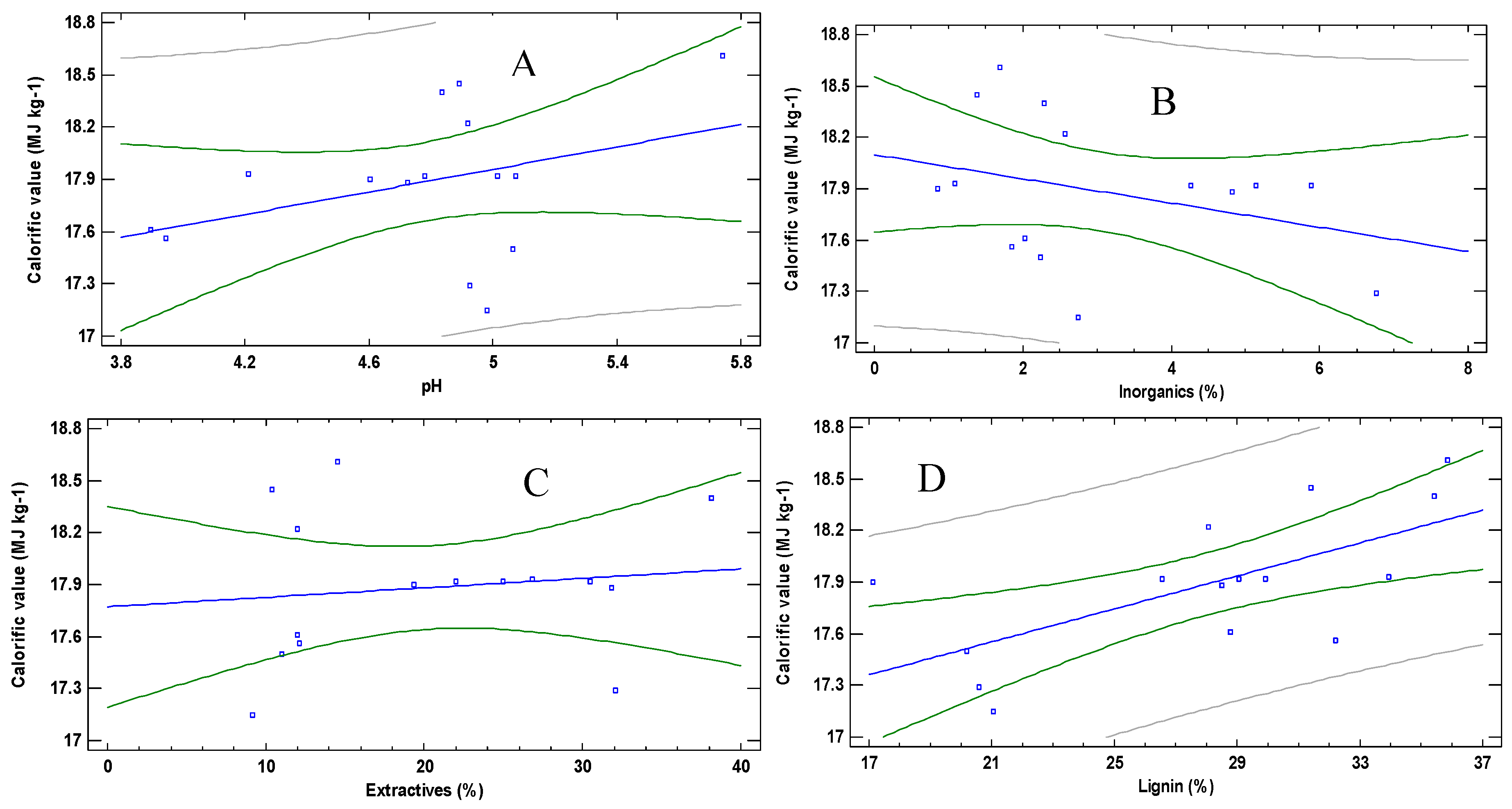Calorific Value and Chemical Composition of Five Semi-Arid Mexican Tree Species
Abstract
:1. Introduction
2. Experimental Section
2.1. Collection Site
2.2. Sampling and Sample Preparation
2.3. Determination of Calorific Value
2.4. Chemical Analysis and Determination of Ash Content
2.5. Statistical Analysis
3. Results and Discussion
3.1. Calorific Value
3.2. Chemical Constituents
3.2.1. pH
3.2.2. Ash Content
3.2.3. Mineral Elements
3.2.4. Extractive Compounds
3.2.5. Runkel Lignin
3.3. Correlations between Calorific Value and Chemical Components in Different Sections of the Studied Species
4. Conclusions
Acknowledgments
Author Contributions
Conflicts of Interest
References
- Orea, U.V.; Carballo, L.R.A.; Cordero, E.M. Apuntes sobre la composición química de la madera. Monography published. 2004. Available online: http://www1.monografias.com/trabajos15/composicion-madera/composicion-madera.shtml (accessed on 22 September 2015).
- Twenergy. La biomasa forestal se abre paso en México. 2014. Available online: http://twenergy.com/a/la-biomasa-forestal-se-abre-paso-en-mexico-1225 (accessed on 28 July 2015).
- Gutiérrez, Y. Crisis energética en el mundo. 2012. Available online: http://www.miambiente.com.mx/sustentabilidad1/crisis-energetica-en-el-mundo (accessed on 16 August 2015).
- Mediavilla, M. Una visión global de la crisis energética. Revista. El Ecologista. N° 73. 2012. Available online: http://www.ecologistasenaccion.org/article8042.html (accessed on 19 June 2015).
- Semarnat (Secretaría de Medio Ambiente y Recursos Naturales). Compendio de Estadística Ambientales. 2010. Available online: http://aplicaciones.semarnat.gob.mx/estadisticas/compendio2010/index.html (accessed on 23 June 2015).
- Rzedowski de Calderón, G.; Rzedowski, J. Presentación. Guía para los autores y normas editoriales. Flora del Bajío y de Regiones Adyacentes. In Fascículo Complementario I; Instituto de Ecología A.C. Centro Regional del Bajío: Pátzcuaro, Michoacan, Mexico, 1991. [Google Scholar]
- Instituto Nacional de Estadística, Geografía e Informática (INEGI). Carta de uso del suelo y vegetación. Hoja Pachuca; Esc. 1:1 000 000; Sistema meteorológico mexicano: Mexico City, Mexico, 1997. [Google Scholar]
- González, M.F. Las Zonas Áridas y Semiáridas de México y su Vegetación; Secretaría de Medio Ambiente y Recursos Naturales, Instituto Nacional de Ecología: Mexico City, Mexico, 2012. [Google Scholar]
- Toledo, V.M.; Ordoñez, M.J. The biodiversity scenario of México: A review of terrestrial habitats. In Biological Diversity of Mexico: Origins and Distribution; Ramamoorthy, T.P., Bye, R., Lot, A., Fa, J., Eds.; Oxford University Press: New York, NY, USA, 1993; pp. 757–777. [Google Scholar]
- Challenger, A. Utilización y Conservación de los Ecosistemas Terrestres de México. Pasado, Presente y Futuro; Comisión Nacional para el Conocimiento y Uso de la Biodiversidad-Instituto de Biología, Universidad Nacional Autónoma de México: Mexico City, Mexico, 1998. [Google Scholar]
- Rojas, L.L. Evaluación de la Composición química y Propiedades físicas de Madera y Corteza de Cuatro coníferas Para la Producción de Bioenergía. Tesis de Maestría, Facultad de Ciencias Forestales, Universidad Autónoma de Nuevo León, México, 2013; p. 55. [Google Scholar]
- García-Hernández, J.; Jurado, E. Characterization of scrub in pristine conditions at Linares, N.L., Mexico. Ra Ximhai 2008, 1, 1–21. [Google Scholar]
- Correa, J.B. Evaluación y cuantificación de los cambios del uso del suelo mediante imágenes de Satélite en los municipios de Linares y Hualahuises, N.L. Tesis Profesional, Fac. de Ciencias Forestales, U.A.N.L., México, 1996; p. 47. [Google Scholar]
- Elizondo, A. El mercado de la madera en México. Informes en Productos Mexicanos de Madera Certificada. Dirección General de Investigación en Política y Economía Ambiental. Instituto Nacional de Ecología, 2006. Available online: www.ine.gob.mx/dgipea/bosq_madera.html (accessed on 10 October 2015).
- Borja, V.M. Aprovechamiento de los Residuos Forestales Para uso Energético; Universidad Politécnica de Valencia: España, Spain, 2006. [Google Scholar]
- FAO. Conservación de Energía en las Industrias Mecánicas Forestales; FAO: Rome, Italy, 1991; p. 93. [Google Scholar]
- García, R.; Pizarro, C.; Lavín, A.G.; Bueno, J.L. Characterization of Spanish biomass wastes for energy use. Bioresour. Technol. 2012, 103, 249–258. [Google Scholar] [CrossRef] [PubMed]
- Vassilev, S.V.; Baxter, D.; Andersen, L.K.; Vassileva, C.G.; Morgan, T.J. An overview of the organic and inorganic phase composition of biomass. Fuel 2012, 94, 1–33. [Google Scholar] [CrossRef]
- Jara, E.R.P. O Poder calorífico de Algumas Madeiras que Ocorrem no Brasil; Instituto de Pesquisas Tecnológicas: São Paulo, Brasil, 1989; p. 6. [Google Scholar]
- Werkelin, J.; Skrifvars, B.J.; Zevenhoven, M.; Holmbom, B.; Hupa, M. Chemical forms of ash-forming elements in woody biomass fuels. Fuel 2010, 89, 481–493. [Google Scholar] [CrossRef]
- Cunha, M.P.; Pontes, C.L.; Cruz, F.I.; Cabral, M.F.; Cunha Neto, Z.B.; Barbosa, A.P. Estudio Químico de 55 especies lenhosas para geracao de energía em caldeiras. In 3º. Encontro Brasilerio em madeiras e em estruturas de madera. Anais, v.2; Instituto Brasileiro da Madeira e das Estruturas de Madeira (Ibramem): Sao Carlos, Brasil, 1989. [Google Scholar]
- Foroughbakhch, R.P.; Hernández-Piñero, J.L.; Carrillo-Parra, A. Adaptability, growth and firewood volume yield of multipurpose tree species in semiarid regions of Northeastern Mexico. Int. J. Agric. Pol. Res. 2014, 2, 444–453. [Google Scholar]
- García, E. Modificaciones al Sistema de Clasificación Climática de Koppen Para Adaptarlo a las Condiciones de la República Mexicana, 3r ed.; UNAM: México D.F., 2004; p. 252. [Google Scholar]
- Maginot, N.H.; Rahim, F.P.; Artemio, C.P.; Lidia-Rosaura, S.C. Estimation of Timber Production of Five Species of the Tamaulipas Thorny Shrubs Growing in Native Stands and Plantations. OJF 2014, 4, 239–248. [Google Scholar] [CrossRef]
- Technical Association for Pulp and Paper Industry (TAPPI). TAPPI Test Methods (1994–1995); TAPPI Press: Atlanta, GA, USA, 2000. [Google Scholar]
- ISO 17225, 1. Solid Biofuels—Fuel Specifications and Classes—Part 1: General Requirements; International Organization for Standardization: Geneva, Switzerland, 2014. [Google Scholar]
- Sandermann, W.; Rothkamm, M. Über die Bedeutung der pH-Werte von Handelshölzern und deren Bedeutung fur die Praxis. Holz. Roh. Werkst. 1959, 17, 433–440. [Google Scholar] [CrossRef]
- Téllez, S.C.; Ochoa-Ruíz, H.G.; San Juan-Dueñas, R.; Rutiaga-Quiñones, J.G. Componentes químicos del duramen de Andira inermis (W. Wright) DC. (Leguminosae). Rev. Chapingo. SER CIE 2010, 16, 87–93. [Google Scholar]
- Schwanninger, M.; Hinterstoisser, B. Comparison of the classical wood extraction method using a soxhlet apparatus with an advanced extraction method. Holz. Roh. Werkst. 2002, 60, 343–346. [Google Scholar] [CrossRef]
- Runkel, R.; Wilke, K.D. Zur Kenntnis des thermoplastischen Verhaltens von Holz. Holz. Roh. Werkst. 1951, 9, 260–270. [Google Scholar] [CrossRef]
- Statistical Graphics Corporation. Statgraphics Centurion (Computer Program) Version XV. Warrenton: Statistical Graphics Corporation, 2002. Available online: www.statgraphics.com (accessed on 21 July 2015).
- Kollmann, F. Tecnología de la Madera y sus Aplicaciones; Instituto Forestal de Investigaciones y Experiencias y Servicio de la Madera: Madrid, España, 1959; Volume 1. [Google Scholar]
- Quirino, W. Poder calorífico da madeira e de materiais ligno-celulósicos. Rev. Madeira 2005, 89, 100–106. [Google Scholar]
- Francescato, V.; Antonini, E.; Bergomi, L.Z.; Metschina, C.; Schnedl, C.; Krajnc, N.; Koscik, K.; Gradziuk, P.; Nocentini, G.; Stranieri, S. Wood Fuels Handbook; AIEL– Italian Agriforestry Energy Association: Legnaro, Italy, 2008. [Google Scholar]
- McNamara, W.S.; Sullivan, S.E.; Higgins, J.C. pH Measurements on northeastern woods. Wood Sci. 1970, 3, 48–51. [Google Scholar]
- Fengel, D.; Wegener, G. Wood Chemistry, Ultrastructure, Reactions; Walter de Gruyter: Berlín, Germany, 1989; p. 415. [Google Scholar]
- Volz, K.R. Influence of inorganic contento n the pH of bark. Holz-Zentralbl. 1971, 97, 1783. [Google Scholar]
- Young, H.E.; Guinn, V.P. Chemical elements in complete mature trees. Forest. Prod. J. 1966, 21, 56–59. [Google Scholar]
- Guadalfajara, A.B. Producción de sal Culinaria de Alta Calidad con Tecnologías Renovables. Tesis, Escuela Técnica superior de Ingeniería (ICAI), Universidad Pontificia Comillas de Madrid, Spain, 2015; p. 125. [Google Scholar]
- Ávila-Calderón, L.E.; Rutiaga-Quiñones, J.G. Chemical components of the wood and bark of Haematoxylum brasiletto Karsten (Leguminosae). Madera y Bosque 2014, 20, 153–158. [Google Scholar]
- Hon, D.; Shiraichi, N. Wood and Cellulosic Chemistry, 2nd ed.; Mercel Dekker: New York, NY, USA, 2001; p. 914. [Google Scholar]
- Gil, M.F. Elementos de Fisiología Vegetal; Ediciones Mundi-Prensa: Madrid, España, 1995. [Google Scholar]
- Martínez-Pérez, R.; Pedraza-Bucio, F.E.; Apolinar-Cortes, J.; López-Miranda, J.; Rutiaga-Quiñones, J.G. Poder calorífico y material inorgánico en la corteza de seis árboles frutales. Rev. Chapingo SER CIE 2012, 18, 375–384. [Google Scholar]
- Correa-Méndez, F.; Carrillo-Parra, A.; Rutiaga-Quiñones, J.G.; Márquez-Montesino, F.; González-Rodríguez, H.; Jurado-Ybarra, E.; Garza-Ocañas, F. Contenido de humedad y sustancias inorgánicas en subproductos maderables de pino para su uso en pélets y briquetas. Rev. Chapingo SER CIE 2014, 20, 77–88. [Google Scholar]
- Revilla, G.E. Química de la Madera de Cuatro Pinos Mexicanos de la Subsección Cembroides. Tesis, Universidad Autónoma Chapingo, Chapingo, Texcoco, Edo. de México, México, 2011. [Google Scholar]
- Biedermann, F.; Obernberger, I. Ash-related problems during biomass combustion and possibilities for a sustainable ash utilization, 2005. Available online: http://www.bios-bioenergy.at/uploads/media/Paper-Biedermann-AshRelated-2005-10-11.pdf (accessed on 22 December 2015).
- Obernberger, I. Nutzung fester biomasse in verbrennungsanlagen unter besonderer berücksichtigung des verhaltens aschebildender elemente, schriftenreihe “Thermische Biomassenutzung”; DBV-Verlag der Technischen Universität Graz: Graz, Autria, 1997. [Google Scholar]
- Van Loo, S.; Koppejan, J. Handbook of Biomass Combustion and Co-Firing; Bioenergy task 32; International Energy Agency (IEA): Amsterdam, Netherlands, 2002. [Google Scholar]
- Miles, T.R. Alkali Deposits Found in Biomass Power Plants; Research Report NREI/TP-443-8142-SAND 96-8225; National Renewable Energy Laboratory: Oakridge, TN, USA, 1996; Volume I and II.
- Ramos-Pantaleón, D.; Ávila-Calderón, L.E.A.; Ochoa Ruíz, H.G.’; Rutiaga- Quiñones, J.G. Contenido de sustancias extraíbles en la madera de Enterolobium cyclocarpum (Jacq.) Griseb. (Leguminosae). Cienc. Nicolaita 2011, 53, 7–19. [Google Scholar]
- Poblete, H.; Rodríguez, S.; Zárate, M. Extraíbles de la Madera, sus Características y Efectos Sobre la Utilización de esta Materia Prima; Publicación docente núm. 34; Facultad de Ciencias Forestales; Universidad Austral de Chile: Valdivia, Chile, 1991; p. 51. [Google Scholar]
- Ávila, L.E.; Herrera., M.A. Efecto de los extraíbles en tres propiedades físicas de la madera de Enterolobium cyclocarpum procedente de Michoacán, México. Bosque 2012, 33, 115–120. [Google Scholar] [CrossRef]
- Rodríguez, L.M.E. Determinación de los componentes químicos de la madera de pino blanco (Pinus pseudostrobus Lindl.) proveniente de la finca Las Victorias, Patzún, Chimaltenango. Tesis Profesional, Escuela de Ingeniería Química, Universidad de San Carlos de Guatemala, Ciudad de Guatemala, Guatemala, 2005; p. 90. [Google Scholar]
- Fonseca, M.R. Determinación de la composición química de la madera de pino candelillo (Pinus maximinoi H.E. Moore) procedente de la finca Río Frío, Tactic, Alta Verapaz. Tesis Profesional, Escuela de Ingeniería Química, Universidad de San Carlos de Guatemala, 2006; p. 125. [Google Scholar]
- Rutiaga-Quiñones, J.G.; Pedraza Bucio, F.E.; López Albarrán, P. Componentes químicos principales de la madera de Dalbergia granadillo Pittier y de Platymiscium lasiocarpum Sandw. Rev. Chapingo SER CIE 2010, 16, 179–186. [Google Scholar] [CrossRef]
- Bernabé-Santiago, R.; Ávila-Calderón, L.E.A.; Rutiaga-Quiñones, J.G. Componentes químicos de la madera de cinco especies de pino del municipio de Morelia, Michoacán. Madera Bosques 2013, 19, 21–35. [Google Scholar]
- Rutiaga Quiñones, J.G. Chemische und biologische Untersuchungen zum Verhalten dauerhafter Holzarten und iher Extrakte gegenüber holzabbuenden Pilzen; Buchverlag Gräfelfing: München, Germany, 2001; p. 201 S. [Google Scholar]




| Common Name | Scientific Name | Families | BD (cm) | DBH (cm) | H (m) | C (m2/ind.) |
|---|---|---|---|---|---|---|
| Barreta | Helietta parvifolia (Gray.) Benth. | Rutaceae | 4.40 | 3.05 | 5.00 | 6.78 |
| Ébano | Ebenopsis ébano (Berl.) Barneby | Mimosaceae | 7.90 | 5.95 | 4.80 | 7.60 |
| Huajillo | Acacia berlandieri Benth | Mimosaceae | 3.10 | 2.05 | 3.25 | 8.53 |
| Tenaza | Havardia pallens (Benth.) Britton & Rose. | Mimosaceae | 5.20 | 3.98 | 4.80 | 6.72 |
| Uña de gato | Acacia wrightii Benth | Mimosaceae | 7.60 | 4.40 | 3.70 | 5.64 |
| Species | Biomass Components | pH | Ash 1 | Extractives 1 | Lignin 2 |
|---|---|---|---|---|---|
| Helietta parvifolia | T | 5.64 ± 0.23 | 1.70 ± 0.60 | 14.56 ± 1.08 | 35.94 ± 1.01 |
| B | 4.89 ± 0.35 | 1.38 ± 0.36 | 10.38 ± 0.97 | 31.39 ± 0.61 | |
| M | 4.93 ± 0.21 | 6.76 ± 1.50 | 32.08 ± 0.52 | 20.61 ± 0.37 | |
| L | 5.30 ± 0.03 | 11.79 ± 1.29 | -- | -- | |
| Ebenopsis ebano | T | 4.84 ± 0.06 | 2.28 ± 0.49 | 38.12 ± 1.05 | 35.43 ± 0.20 |
| B | 4.92 ± 0.13 | 2.57 ± 0.44 | 11.99 ± 2.13 | 28.08 ± 0.34 | |
| M | 5.08 ± 0.02 | 5.14 ± 0.48 | 24.95 ± 0.48 | 29.92 ± 0.59 | |
| L | 5.17 ± 0.35 | 7.18 ± 0.80 | -- | -- | |
| Acacia berlandieri | T | 3.90 ± 0.04 | 2.03 ± 0.59 | 11.97 ± 0.27 | 28.78 ± 0.54 |
| B | 4.98 ± 0.06 | 2.75 ± 0.12 | 9.16 ± 1.99 | 21.04 ± 1.68 | |
| M | 4.78 ± 0.01 | 5.89 ± 1.53 | 30.48 ± 0.18 | 26.56 ± 0.30 | |
| L | 4.89 ± 0.31 | 5.77 ± 0.12 | -- | -- | |
| Havardia pallens | T | 3.95 ± 0.01 | 1.85 ± 0.46 | 12.10 ± 1.94 | 32.21 ± 0.69 |
| B | 5.07 ± 0.53 | 2.34 ± 0.65 | 10.99 ± 1.42 | 20.18 ± 1.39 | |
| M | 4.73 ± 0.12 | 4.82 ± 0.73 | 31.81 ± 1.06 | 28.51 ± 0.25 | |
| L | 5.14 ± 0.04 | 8.26 ± 1.46 | -- | -- | |
| Acacia wrightii | T | 4.21 ± 0.41 | 1.09 ± 0.38 | 26.84 ± 1.29 | 33.94 ± 2.67 |
| B | 4.61 ± 0.04 | 0.86 ± 0.28 | 19.37 ± 0.11 | 17.14 ± 1.48 | |
| M | 5.02 ± 0.11 | 4.26 ± 0.76 | 22.01 ± 0.43 | 29.04 ± 0.88 | |
| L | 5.05 ± 0.08 | 8.18 ± 1.21 | -- | -- | |
| P | 0.375 | 0.000 ** | 0.019 * | 0.014 * |
| N° | Parameters | Equations | R2 | r | P |
|---|---|---|---|---|---|
| 1 | CV & pH | CV = 16.3406 + 0.323322*pH | 13.13 | 0.36 | 0.184 |
| 2 | CV & Inorganics | CV = 18.0988 − 0.070599*Inorganics | 9.77 | −0.31 | 0.257 |
| 3 | CV & Extractives | CV = 17.7722 + 0.00546609*Extractives | 1.59 | 0.13 | 0.654 |
| 4 | CV & Lignin | CV = 16.5477 + 0.0478768*Lignin | 44.04 | 0.66 | 0.007* |
| 5 | CV, pH, Inorganics | CV = 16.2072 + 0.411899*pH - 0.0951561*Inorganics | 29.90 | - | 0.119 |
| 6 | CV, pH, Extractives | CV = 16.2524 + 0.320308*pH + 0.00501283*Extractives | 14.47 | - | 0.392 |
| 7 | CV, pH, Lignin | CV = 14.8803 + 0.343794*pH + 0.0488191*Lignin | 58.86 | - | 0.005* |
| 8 | CV, Inorganics, Extractives | CV = 17.8816 − 0.123761*Inorganics + 0.018522*Extractives | 22.53 | - | 0.216 |
| 9 | CV, Inorganics, Lignin | CV = 16.7467 − 0.0400171*Inorganics + 0.0451078*Lignin | 47.03 | - | 0.022* |
| 10 | CV, Extractives, Lignin | CV = 16.5365 + 0.000864855*Extractives + 0.0476448*Lignin | 44.08 | - | 0.031* |
© 2016 by the authors; licensee MDPI, Basel, Switzerland. This article is an open access article distributed under the terms and conditions of the Creative Commons by Attribution (CC-BY) license (http://creativecommons.org/licenses/by/4.0/).
Share and Cite
Ngangyo-Heya, M.; Foroughbahchk-Pournavab, R.; Carrillo-Parra, A.; Rutiaga-Quiñones, J.G.; Zelinski, V.; Pintor-Ibarra, L.F. Calorific Value and Chemical Composition of Five Semi-Arid Mexican Tree Species. Forests 2016, 7, 58. https://doi.org/10.3390/f7030058
Ngangyo-Heya M, Foroughbahchk-Pournavab R, Carrillo-Parra A, Rutiaga-Quiñones JG, Zelinski V, Pintor-Ibarra LF. Calorific Value and Chemical Composition of Five Semi-Arid Mexican Tree Species. Forests. 2016; 7(3):58. https://doi.org/10.3390/f7030058
Chicago/Turabian StyleNgangyo-Heya, Maginot, Rahim Foroughbahchk-Pournavab, Artemio Carrillo-Parra, José Guadalupe Rutiaga-Quiñones, Volker Zelinski, and Luis Fernando Pintor-Ibarra. 2016. "Calorific Value and Chemical Composition of Five Semi-Arid Mexican Tree Species" Forests 7, no. 3: 58. https://doi.org/10.3390/f7030058
APA StyleNgangyo-Heya, M., Foroughbahchk-Pournavab, R., Carrillo-Parra, A., Rutiaga-Quiñones, J. G., Zelinski, V., & Pintor-Ibarra, L. F. (2016). Calorific Value and Chemical Composition of Five Semi-Arid Mexican Tree Species. Forests, 7(3), 58. https://doi.org/10.3390/f7030058







